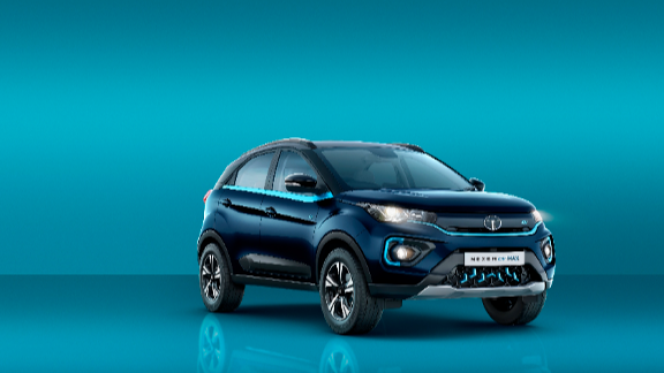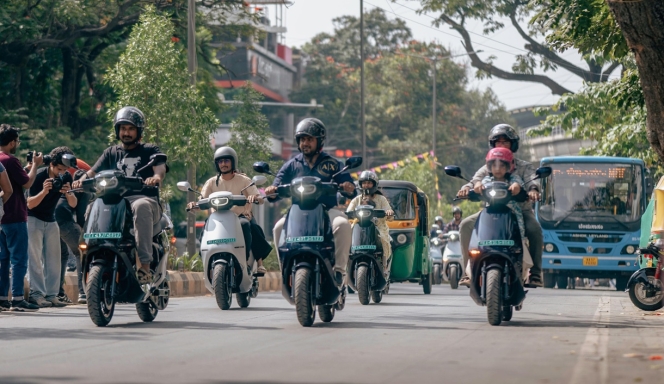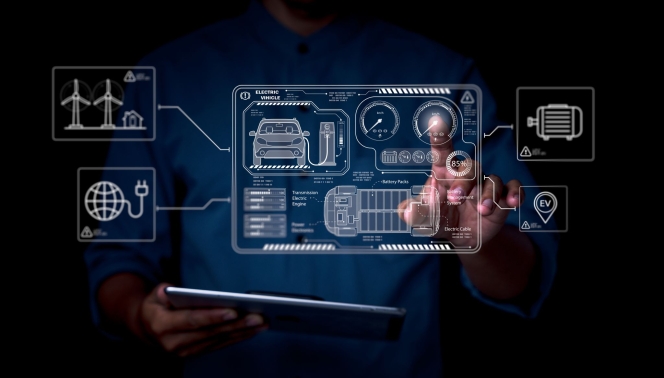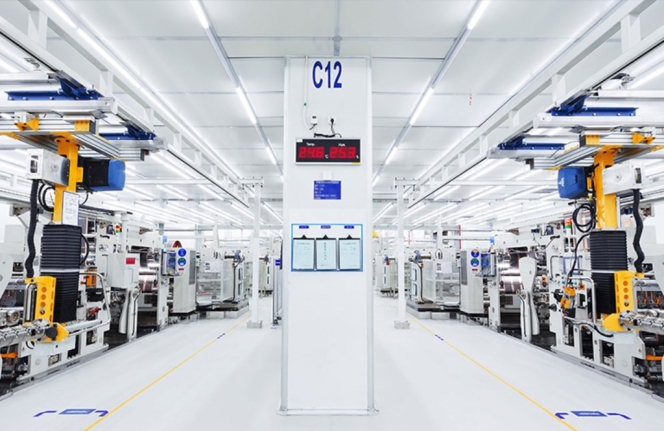Tata Motors Launches New Nexon EV MAX at INR 17.74 lakh
- By MT Bureau
- May 12, 2022

Tata Motors has launched the new Nexon EV MAX for a starting price of INR 17.74 lakh (ex-showroom All India).
The company said in a release that the Nexon EV MAX is powered by high voltage state-of-the-art Ziptron technology and would be available in two trim options – the Nexon EV Max XZ+ and Nexon EV Max XZ+ Lux. It also has three colours – Intensi-Teal (exclusive to the Nexon EV MAX), Daytona Grey and Pristine White. Dual tone body colour will be offered as a standard, the release said.
Equipped with a 40.5 kWh Lithium-ion battery pack, the Nexon EV Max offers 33 per cent higher battery capacity, delivering an anxiety-free ARAI certified range of 437 km (under standard testing conditions), the company said. The Nexon EV MAX produces 105 kW (143 PS) of power and delivers an instant torque of 250 Nm available at push of the pedal, resulting in 0 to 100 sprint times in under 9 secs.
The Nexon EV Max will be available with options of a 3.3 kW charger or a 7.2 kW AC fast charger. The 7.2 kW AC fast charger can be installed either at home or at workplace, which helps in reducing charging time to 6.5 hours. It will support a faster charging time of 0 - 80% in just 56 mins from any 50 kW DC fast charger, the company claimed.
Vivek Srivatsa, Head, Marketing, Sales and Service Strategy, Tata Passenger Electric Mobility, said, “We at Tata Motors are committed to the rapid electrification of mobility in the country, and are humbled by the overwhelming response that we are receiving from our customers. Keeping customer centricity at the core and dedicated to bringing in newer products at regular and quick intervals, we are elated to launch the new Nexon EV MAX – an SUV that offers all EV users MAX freedom to undertake regular and uninterrupted long distance travel. This SUV offers more range, more power, and faster charging while improving the overall driving efficiency, providing an uncompromised EV ownership experience.”
Anand Kulkarni, Vice President, Product Line & Operations, Tata Passenger Electric Mobility, said, “The Nexon EV Max is a testament to our state-of-the-art high voltage EV architecture Ziptron, designed for unique Indian driving and weather conditions. It offers significantly enhanced range, safety, performance and luxury to give a truly MAX experience to our customers. With more than 30 new features in the Nexon EV MAX and 3 mainstream EV offerings for personal segment buyers, Tata Motors is set on an ever evolving journey to bring performance and technology to the fore and encouraging the Indian customer to #EvolvetoElectric!”
The striking exterior of the Nexon EV MAX has been complemented with significantly modernised interiors to match the progressing preferences of the discerning customers, the release pointed out. The central console has undergone a significant revamp and gets a new uncluttered and clean design, it features a Jewelled Control Knob with active mode display, all new Makarana beige interiors, leatherette seats with ventilation for front passengers, air purifier, wireless smartphone charging, auto-dimming IRVM and cruise control.
Nexon EV Max features three driving modes – eco, city and sport and gets eight new features on the upgraded ZConnect 2.0 connected car technology. The ZConnect app offers 48 connected car features. This will help in attaining deeper drive analytics and diagnostics. The add-on feature list covers a smartwatch integration, auto/manual DTC check, setting a limit for charging, monthly vehicle reports, and enhanced drive analytics.
With Nexon EV MAX, Tata Motors has introduced a Multi-Mode Regen feature which will help customers to easily adjust the level of regenerative braking through switches on the floor console. Customers can choose between 4 regen levels based on the driving conditions: Level 0 with nil recuperative braking, going up to the highest Level 3 aiding single pedal driving. The Company has also added an intuitive feature – auto brake lamps which gets activated once a certain level of regen is achieved, this helps to alert fellow motorists.
The company said that the Nexon MAX comprises of enhanced safety features like ESP with i-VBAC (intelligent – Vacuum-less Boost & Active Control), Hill Hold, Hill Descent Control, Electronic Parking Brake with Auto Vehicle Hold and all 4-Disc brakes. Making it a complete package, the promise of reliability and durability of Ziptron continues on Nexon EV Max with its battery and motor pack being IP67 rated for a weather-proof and worry-proof performance. (MT)
Ola Electric Begins Mass Deliveries Of 4680 Bharat Cell Powered Vehicles
- By MT Bureau
- December 08, 2025

Ola Electric has announced the commencement of mass deliveries of its 4680 Bharat Cell-powered vehicles. The S1 Pro+ 5.2 kWh is the first product to be powered by the company’s indigenously manufactured 4680 Bharat Cell battery pack, which delivers more range, better performance and enhanced safety.
With its own battery packs in the vehicles, Ola Electric is now India's first company to fully own the battery pack and cell manufacturing process in-house.
The S1 Pro+ 5.2 kWh is powered by a 13 kW motor, offering acceleration of zero to 40 kmph in just 2.1 seconds. It comes with an impressive 320 km range (IDC with DIY mode).
The S1 Pro+ features four riding modes (Hyper, Sports, Normal and Eco) and also offers enhanced safety with category-first dual ABS and disk brakes in the front and rear. It also gets enhanced ergonomics and comfort, a two-tone seat with supportive foam, body-coloured mirrors, a die-cast aluminium grab handle, rim decals and an expanded colour palette comprising Passion Red, Porcelain White, Industrial Silver, Jet Black, Stellar Blue and Midnight Blue.
“The excitement for S1 Pro+ has been phenomenal. Deliveries are now in full swing, and customers are proudly riding India’s first scooters powered by our own 4680 Bharat Cell. This is a big moment, not just for Ola, but for India’s journey towards becoming a global EV hub. With the national rollout starting soon, we are now ready to take this breakthrough product and technology to every corner of the country,” an Ola Electric spokesperson said.
Trinseo Launches Fourth-Generation Binder For The Next Wave Of EV Batteries
- By MT Bureau
- December 03, 2025

Trinseo has introduced its latest innovation, the Fourth-Generation SBR Binder Platform, designed to meet the evolving demands of electric vehicles and battery energy storage systems. This development reflects the company's strategic focus on delivering high-performance materials essential for the global shift towards sustainable energy.
The platform results from advanced polymer science and collaboration with battery manufacturers, targeting key industry requirements such as increased energy density, superior durability and more efficient production. It provides a significant improvement in peel strength, enabling stronger electrode bonds, thicker coatings and higher manufacturing speeds. These attributes are vital for developing higher-capacity batteries that can extend driving range and improve storage solutions.
The inaugural product, VOLTABOND 109 Latex Binder, offers this next-generation performance with broad compatibility across various anode materials and manufacturing processes. Its design ensures excellent stability and low resistance, supporting faster charging and long-term reliability. To ensure robust supply, Trinseo will produce the platform locally within major global regions, enhancing responsiveness to battery production hubs.
Rooted in decades of expertise, this new platform establishes a foundation for future innovations tailored to diverse customer needs across the battery value chain.
CATL And Stellantis Begin Work On EUR 4.1 Billion Spanish Battery Plant
- By MT Bureau
- November 28, 2025

CATL and Stellantis broke ground on a EUR 4.1 billion battery plant in Figueruelas, Spain, on 26 November. The 50:50 joint venture will produce lithium-iron-phosphate battery cells and targets an annual production capacity of 50 GW/h.
The project, which is Spain’s largest battery factory, is backed by over EUR 300 million in EU funds, with production expected to start in late 2026.
According to unions, around 2,000 Chinese workers will help construct the site, a point of contention with local authorities and residents. Also, 3,000 Spanish staff are to be hired and trained later.
Spanish authorities and residents have voiced concerns about job opportunities for local workers and potential strain from the influx of foreign employees. CATL Vice President Meng Xiangfeng said earlier in November the company needed experienced technicians to build and fine-tune production lines, with plans to train local workers to take over operations gradually.
David Romeral, Director General of CAAR Aragon, a network of automotive businesses in the region, said: “We don’t know this technology, these components – we’ve never made them before. They’re years ahead of us. All we can do is watch and learn.”
The regional government is organising work permits for arriving workers while seeking to attract battery supply chain companies to Aragon. Some Chinese technicians and managers have already arrived, with several hundred more expected by year-end and nearly 2,000 by the end of next year.
CATL’s approach contrasts with its Hungarian site in Debrecen, where it hired mostly locals to build its European plant. However, a lack of local workers caused production to be delayed from late 2025 into mid-2026. The Figueruelas facility will serve as CATL’s third European manufacturing operation, alongside the Hungarian plant and one in Germany.
- Neuron Energy
- Equanimity Ventures
- Rajiv Dadlani Group
- Thackersay Family Office
- Chona Family Office
- Pratik Kamdar
- Rajesh Sehgal
- Rajiv Dadlani
Neuron Energy Secures INR 310 Million To Expand EV Battery Manufacturing For Four-Wheelers & Buses
- By MT Bureau
- November 27, 2025

Neuron Energy, an EV battery manufacturer, has raised INR 310 million in a Pre-Series B funding round led by Equanimity Ventures, Rajiv Dadlani Group, Thackersay Family Office and Chona Family Office, with participation from Family Offices and HNI investors. With this, Neuron Energy has raised INR 810 million to date.
The funding will be used to expand Neuron Energy’s manufacturing capacity to 3 GWh and to establish a fully automated, large-scale battery facility for electric four-wheelers and buses at Chakan, Pune. The capital will also strengthen the company’s R&D capabilities, accelerate domestic growth, and broaden its footprint in international markets.
Pratik Kamdar, CEO and Co-Founder, Neuron Energy, said, “This Pre-Series B round is a defining step in our mission to industrialise world-class battery manufacturing in India. As EV adoption accelerates, we are focused on building capacity, embedding automation, and pushing the boundaries of performance and reliability. This investment ensures we can deliver at scale, both in India and globally.”
The company said it operates with a low-CapEx and low-OpEx business model. It has been growing profitably year-on-year and is on track to achieve INR 2 billion in revenue this year. The company is also confident of achieving sales of over INR 9 billion, with profitability, over the next few years.
Rajesh Sehgal of Equanimity Ventures, added, "We see immense potential in Neuron Energy’s approach to EV battery innovation and scalability. Their focus on quality, automation, and energy efficiency aligns with the evolving demands of the EV industry in India and beyond. We are proud to support their next phase of growth as they scale into new vehicle categories and manufacturing capacities."
The new facility reinforces the company’s position in two-wheeler EV batteries and signals a strategic entry into heavier vehicle segments. This supports Neuron’s vision to become a comprehensive EV battery solutions provider.
Rajiv Dadlani, from the Family Office of the Rajiv Dadlani Group, said, "Neuron Energy demonstrates remarkable potential to become the market leader, with their renewed focus, in delivering top-quality products. The company and its founders are highly committed to delivering rigorously tested and safe-to-use Li-Ion smart batteries. We are confident that they will continue to thrive and set new standards in the industry."





Comments (0)
ADD COMMENT